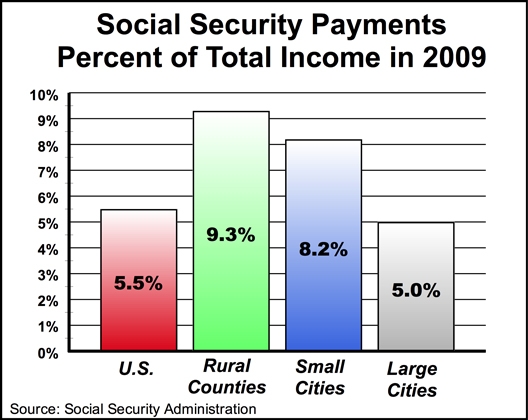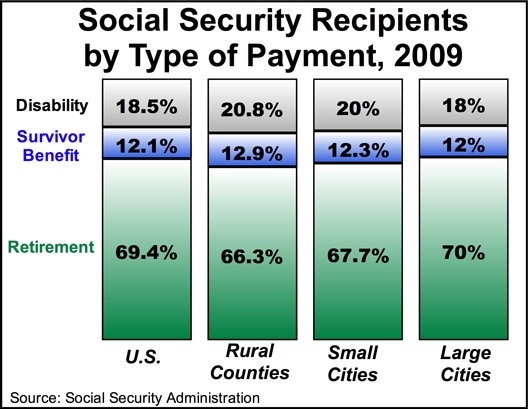

 |
 |
|
|
|
||
| SEARCH | SUBSCRIBE | ||
|
Rural Counties More
Dependent on Social Security
 Social Security Administration/Bureau of Economic Affairs Social Security payments make up a larger proportion of local income in rural counties than in the cities. Rural America is more dependent on income from Social Security than are the nation’s cities. In rural counties, 9.3 percent of total personal income came from Social Security payments in 2009, according to an analysis of government data. That is almost twice the rate found in urban counties, where 5 percent of total income came from monthly Social Security payments. In counties with small cities (under 50,000 population), Social Security is also a larger part of the local economy. In these so-called “micropolitan” counties, Social Security accounted for 8.2 percent of total personal income. Nationally, Social Security makes up 5.5 percent of total personal income. “In many rural places, Social Security is a very critical element of the local economic base,” said Peter Nelson, a geographer at Middlebury College in Vermont. “It’s less important to a place like Los Angeles because there is so much additional economic activity going on there.” Social Security payments are now being debated in Congress as part on an ongoing search for ways to lower the national debt. Late last week, the Associated Press reported both Republicans and Democrats agreed that Social Security should change the way it calculates cost of living increases in monthly benefit checks. The change would slightly reduce payments over time. Under this new calculation, Social Security payments would be reduced by a total of $108 billion in the next decade. Other changes to Social Security have been discussed in Congress as it searches for ways to decrease federal spending. If benefits are cut — or if the eligibility age is increased — rural counties and small cities would be disproportionately affected, according to Peter Nelson. “Cuts would have a bigger negative impact on rural places, absolutely,” Middlebury’s Professor Nelson said. “They are more dependent on Social Security.” Social security payments come in three forms: an old-age pension, a survivor benefit or a disability check. Nationally, 16.7 percent of the population in 2009 received some form of monthly Social Security payments. (To see data for all states and all counties, go here.) In rural counties, however, 23.6 percent of residents receive at least one of these three Social Security benefits. In small cities, 21.2 percent of residents receive a Social Security check.  Social Security Administration/Bureau of Economic Affairs A larger proportion of rural residents receives some kind of Social Security payment. Since a larger proportion of residents receive Social Security payments in rural counties, the per capita payment in rural areas is higher than in the cities. (The per capita payment would be the total amount of Social Security payments in a county in a year divided by the total number of residents.) In rural counties, the per capita income (all residents) from Social Security payments in 2009 was $2,831. In small cities, the per capita rate was $2,642. In the large cities, Social Security income per resident was $2,055.  Social Security Administration/Bureau of Economic Affairs Since more rural residents receive Social Security payments, the per capita average is higher in rural counties. Social Security payments are particularly important to rural counties and small cities because the money is largely spent in the community. “The seniors who get these payments are primarily going to spend their money locally,” said Mark Partridge, a rural economist at Ohio State University. “And they are a key reason why some communities are still viable. If this money dried up, there wouldn’t be a lot of these small towns.” Judith Stallmann, an economist at the University of Missouri, explained that Social Security payments help generate the sales that keep a rural business afloat. “We find that Social Security income can be the difference between success and failure for some local businesses,” Stallmann said. “If you took away, say, 10 percent of the demand, would that local business be able to remain open? Often it’s that 10 percent that keeps them going. Social Security is providing that margin.”  Social Security Administration/Bureau of Economic Affairs Social Security payments go to those over the age of 62 who have filed for benefits, to survivors of insured workers and to those with disabilities. Rural counties have more people who receive disability payments than the nation as a whole. Note: Data included in this story comes from the federal Bureau for Economic Analysis and the Social Security Administration. The figures in this story are from 2009, unless otherwise noted. You can see and download data for every county in your state and the nation from the Southern Rural Development Center at Mississippi State University.
Copyright
© Global Action on Aging |
|